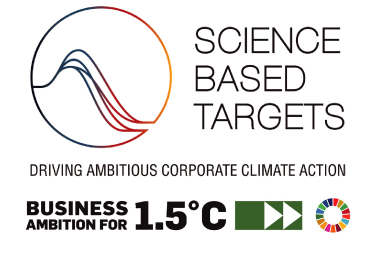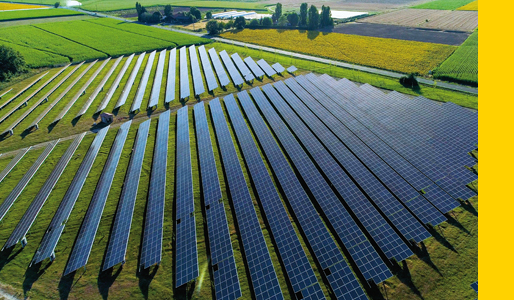Energy and Climate Change
Energy & Climate Change
Our Ambition
Continuously reduce our carbon footprint and our impact on climate change by decreasing our GHG emissions and improving energy efficiency.
2025 GOAL
-20%
energy consumption and GHG emissions*
* Normalized values vs 2016
Five years after the COP21 Paris Agreement, climate change remains one of the biggest threats facing society. At ST, we recognize the urgency of this global issue and, as a multinational company, we take action to mitigate the impact of our activities and engage all our stakeholders. In 2020, we committed to go beyond what we’ve already achieved, by amplifying the positive impact of our technology and accelerating our sustainability initiatives. I 103-1 I
Becoming carbon neutral by 2027
Having in 2019 achieved our 2025 goal regarding greenhouse gas (GHG) emissions (a reduction of 20% per production unit vs 2016), we stepped up our ambition in 2020 and committed to become carbon neutral by 2027.
-19%
GHG emissions vs 2019
Our roadmap to carbon neutrality includes two additional targets:
- compliance with the Paris Agreement’s 1.5°C scenario by 2025, implying a 50% reduction in direct and indirect GHG emissions vs 2018
- sourcing 100% renewable energy by 2027
We are already on our way to achieving these targets. In 2020, we decreased our greenhouse gas (GHG) emissions by 19% in absolute terms compared to 2019.
Summary of net CO2 equivalent emissions I 305-1 I 305-2 I 305-3 I

Orio Bellezza
President, Technology, Manufacturing and Quality
We believe that sustainability is not only important for the world, but that it also provides a strong competitive advantage. Our commitment to be carbon neutral by 2027 is supported by ST management at all levels. We have a robust roadmap sustained by financial investments and important partnerships. On top of that, we can count on our dedicated and engaged teams of experts to find innovative solutions to the technical challenges. Until now, very few semiconductor companies have made such a commitment. We hope it will pave the way for accelerating sustainability together.”
A comprehensive roadmap
Reducing our direct emissions
The use of perfluorinated compounds (PFCs) in the manufacture of semiconductors accounts for a significant share of our direct air emissions, as defined by scope 1 of the GHG protocol. It is therefore a central part of our environmental strategy to reduce their use and ensure they are treated appropriately before being released into the atmosphere.
Our manufacturing sites are equipped with PFC abatement systems to reduce air emissions, and we systematically integrate them into all new equipment. Our Rousset facility (France), which integrated the abatement systems when it was built in 2000, treats 100% of its PFC emissions. In 2020, we pursued our efforts by installing new systems and implementing changes in the manufacturing processes that delivered a 13% reduction in absolute air emissions. The most significant decreases were achieved at our Ang Mo Kio site (Singapore), thanks to investments in abatement systems, and our Catania site (Italy), where a new chiller was installed that operates with a fourth-generation refrigerant gas, which has a global warming potential close to zero.

Focus
Joining the Science Based Targets initiative
As part of our ambitious program to become carbon neutral by 2027, ST has joined the Science Based Targets initiative (SBTi), which provides a clearly defined pathway for companies to reduce greenhouse gas (GHG) emissions. Targets are considered ‘science-based’ if they are in line with what the latest climate science deems necessary to meet the goals of the Paris Agreement – limiting global warming to well below 2°C above pre-industrial levels and pursuing efforts to limit warming to 1.5°C.
By the end of 2020, we were the only semiconductor company with approved targets to limit warmings to no more than 1.5°C, representing the highest level of ambition. By reporting annually on our progress, the SBTi will help us monitor progress towards our target of reducing our direct and indirect emissions (scopes 1 and 2) by at least 50% compared to 2018, and sourcing 80% of our electricity from renewable sources by 2025.
CO2 emissions equivalent
I 305-4 I SDG 13.1
Per unit of production – normalized values
PFC emissions
I 305-4 I
Per unit of production – normalized values
Saving energy
We increased our energy consumption by 6% in 2020 vs 2019 (in absolute terms), mainly due to the integration of one new manufacturing facility and an extension in another. Although the impact was largely offset by a significant increase in our use of renewable energy (see below), we continue to focus on our energy saving programs.
11
sites certified ISO 50001
All our manufacturing sites develop initiatives to better manage and reduce their energy consumption. During 2020, EHS teams at all our sites worked on 48 improvement projects, saving 14.2GWh of energy. Examples include:
- replacing LED lighting in Bouskoura (Morocco) for an annual saving of 2.5GWh
- free cooling of all electrical rooms and heat recovery in Crolles (France)
- improving water flows and reducing the use of pumps at our Rennes site (France), reducing overall electricity consumption by 20% compared to 2019
ISO 50001 certification helps us to improve energy efficiency and so reduce GHG emissions and energy costs. In 2020, our Calamba site (the Philippines) joined the 10 ST sites already certified (see ST certifications).
In 2021, in the framework of our carbon neutrality program, we will conduct external audits of all our manufacturing sites to identify actions to improve our energy efficiency.
Increasing our use of renewable energy
40% of the total energy we purchased in 2020 came from renewable sources. This represents an increase of 50% compared to 2019, helping to reduce our absolute indirect emissions (scope 2 of GHG) by 20%.
40%
renewable energy
Renewable electricity makes up 70% of the electricity used by our sites in France and Italy. Green sourcing helped us reduce our emissions by the equivalent of 222,563 tons of CO2, enough for 222,563 individual return flights from Paris to New York.
In 2020, as part of our move towards more renewable energy sourcing, our sites at Ang Mo Kio (Singapore), Calamba (the Philippines), Kirkop (Malta), Muar (Malaysia) and Shenzhen (China) purchased green certificates for a total of 95.5GWh.
In 2020, the 1GWh of green electricity produced by the photovoltaic carport at our Bouskoura site (Morocco), among the biggest private installation in the country, partially. powered the clean room. Similarly, the solar power installations at our sites in Catania (Italy) and Grenoble (France) produced 2.1GWh of green electricity.
In 2019, we joined the Apple clean energy initiative, reaffirming our low carbon commitment. As part of this program, we agreed to supply products to Apple that are manufactured with 100% renewable energy. By the end of 2020, we were on track to achieve this target.
In 2021, we will continue our efforts to reach our goal of using 100% renewable energy by 2027. This includes renewable energy power purchase agreements (PPAs), on-site solar electricity generation, and purchasing green electricity certificates. In addition, our Bouskoura site (Morocco) has started developing a wind farm that will supply at least 90% of the power needs of the site starting from the second half of 2021.
Minimizing our indirect emissions from transportation
Reducing CO2 emissions from the transportation of our people and products has been part of our sustainability strategy for 25 years. We report on employee commuting, business travel and transportation of our goods – the three most material categories for us out of the 15 categories defined in scope 3 of the GHG protocol.
-40%
in scope 3 emissions
In 2020, due to the COVID-19 pandemic, we reduced business travel and encouraged eligible employees to work from home. This resulted in a decrease in our scope 3 absolute emissions of 40% compared to 2019. This was mainly due to an 86% decrease in emissions related to business travel.
Reforestation program
We have developed CO2 sequestration programs based on reforestation. Around 6,200 hectares of forests were planted on our behalf between 2002 and 2005. These trees sequestrated 211,000 tons of CO2 in 2020, equivalent to almost 43% of our annual direct emissions(1), but not yet taken into account in our emissions reported.
To become carbon neutral by 2027, we will develop further reforestation and innovative carbon avoidance and sequestration programs.
Acting collectively
We firmly believe our achievements will be greater if we act collectively. Our carbon neutrality program therefore aims to engage customers, employees, investors, candidates, and all our partners. We want to implement collaborative programs and partnerships in all our ecosystems, to promote carbon neutrality among all stakeholders, and to encourage environmental innovations.
Strategic partnerships
Strategic partnership with
Schneider Electric
In 2020, we initiated a strategic partnership with Schneider Electric on carbon neutrality and the co-development of energy-efficient solutions. Both companies will collaborate on:
- reducing overall energy consumption at ST manufacturing and design sites
- applying a renewable energy sourcing strategy across all ST locations
- identifying and implementing the most relevant carbon avoidance and carbon sequestration programs
Transparency towards our stakeholders
By reporting to CDP, we demonstrate to our customers and investors that we are ahead of regulatory and policy changes, we proactively identify and tackle growing risks, and we continually seek new opportunities for action. Our effective performance and management approach were recognized with an A score in the 2020 CDP Climate Change list, positioning ST among the leaders in climate transparency and actions to cut emissions, mitigate climate risks and develop the low-carbon economy.
Third-party audits
In 2020, we initiated ISO 14064 certifications across all our sites. ISO 14064 is an international standard for quantifying and reporting GHG direct and indirect emissions at the organizational level. This gives our sites tools and guidance to select the appropriate GHG sources, data and methodologies, and enhance our reporting. By the end of 2020, our Agrate (Italy), Kirkop (Malta) and Shenzhen (China) sites were audited. All other manufacturing sites will be audited and certified during 2021.
Addressing climate-related risks
Through our Enterprise Risk Management (ERM) program, we identify and assess climate-related risks. The business continuity plans we implement at each site help prevent and protect our operations against climate change and natural disasters (see Risk Management). We adopt a bottom-up approach to assessing risks, allowing us to zoom in on a specific site or to zoom out at Company level. Benchmarking helps us identify the sites most at risk and the risk drivers.
For climate-related risks, we use a framework inspired by the ‘Water Risk Filter’, a tool developed by WWF adapted for carbon risk assessment. We assess:
- physical risks, such as dependence on weather and temperature
- regulatory risks, such as legislation and fines
- reputational risks, such as media exposure and involvement in compensation measures
We also identify risks that are driven by changes in other climate-related developments, such as changing consumer behavior. We are actively involved in researching new products to help our customers develop new energy saving applications, transforming risk into opportunity (see Sustainable Technology).
We support the
TCFD
In 2020, we publicly declared our commitment to the Taskforce on Climate-related Financial Disclosure (TCFD). This means we are working towards implementing TCFD recommendations and reporting how we take actions on climate-related risks and opportunities (see TCFD index).
Contributing to the Sustainable Development Goals
Our commitments and programs related to Energy and Climate Change as described above contribute to:
SDG target 7.3 – By 2030, double the global rate of improvement in energy efficiency.
SDG target 8.4 – Improve progressively, through 2030, global resource efficiency in consumption and production.
SDG target 13.1 – Strengthen resilience and adaptive capacity to climate-related hazards and natural disasters in all countries.
(1) Internal calculation method.
2020 OBJECTIVES |
Status |
Comments |
|
-30% PFCs emissions (tons CO2 per production unit) by 2020 from 2010 baseline. |
|
-25% compared to 2010. |
|
|
+10% green energy each year. |
|
+50% compared to 2019. |
|
80% renewable electricity by 2025 and 100% by 2027. |
NEW |
Science Based Targets. |
|
-50% absolute scope 1 and scope 2 GHG emissions by 2025 from 2018 baseline. |
NEW |
Science Based Targets. |


